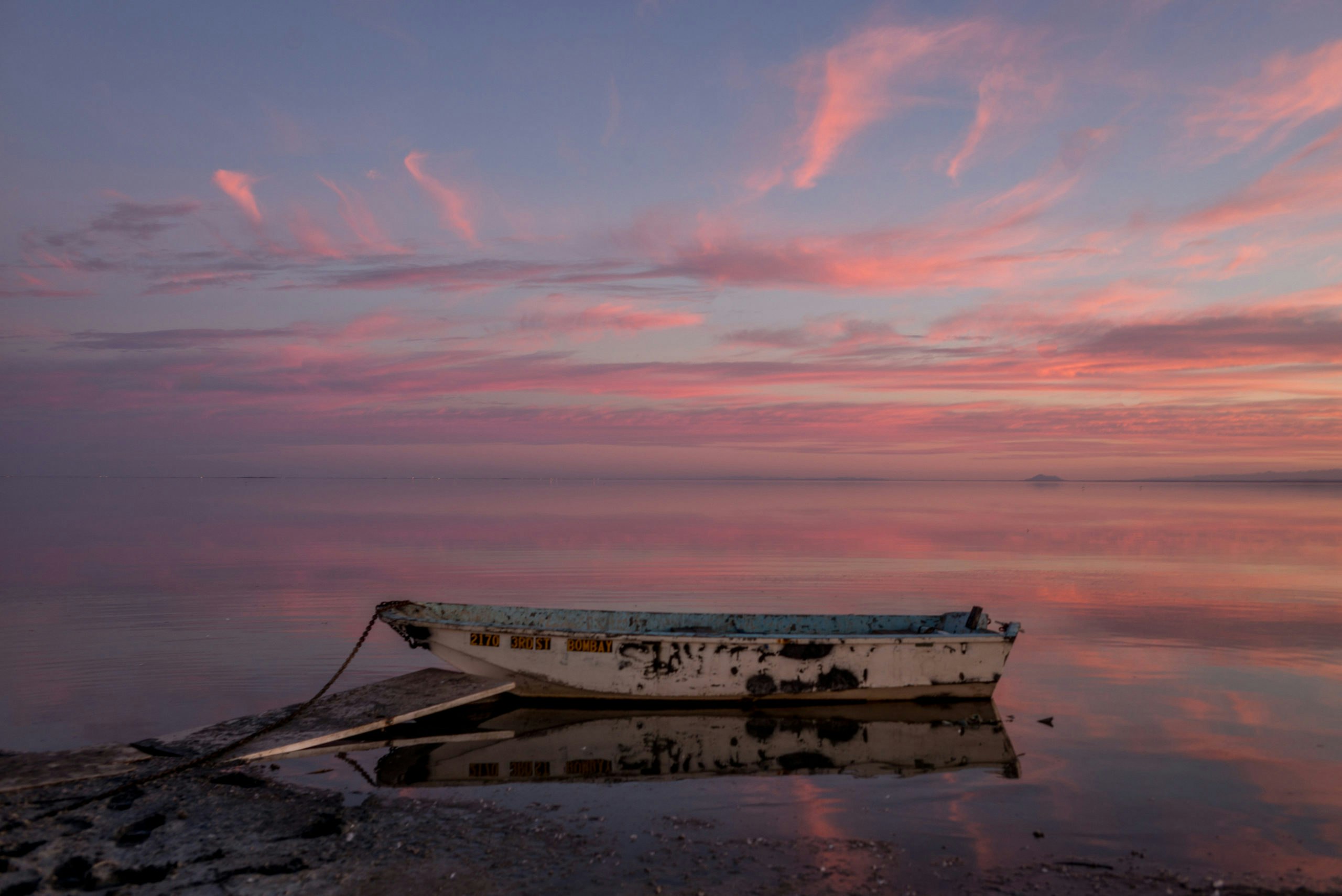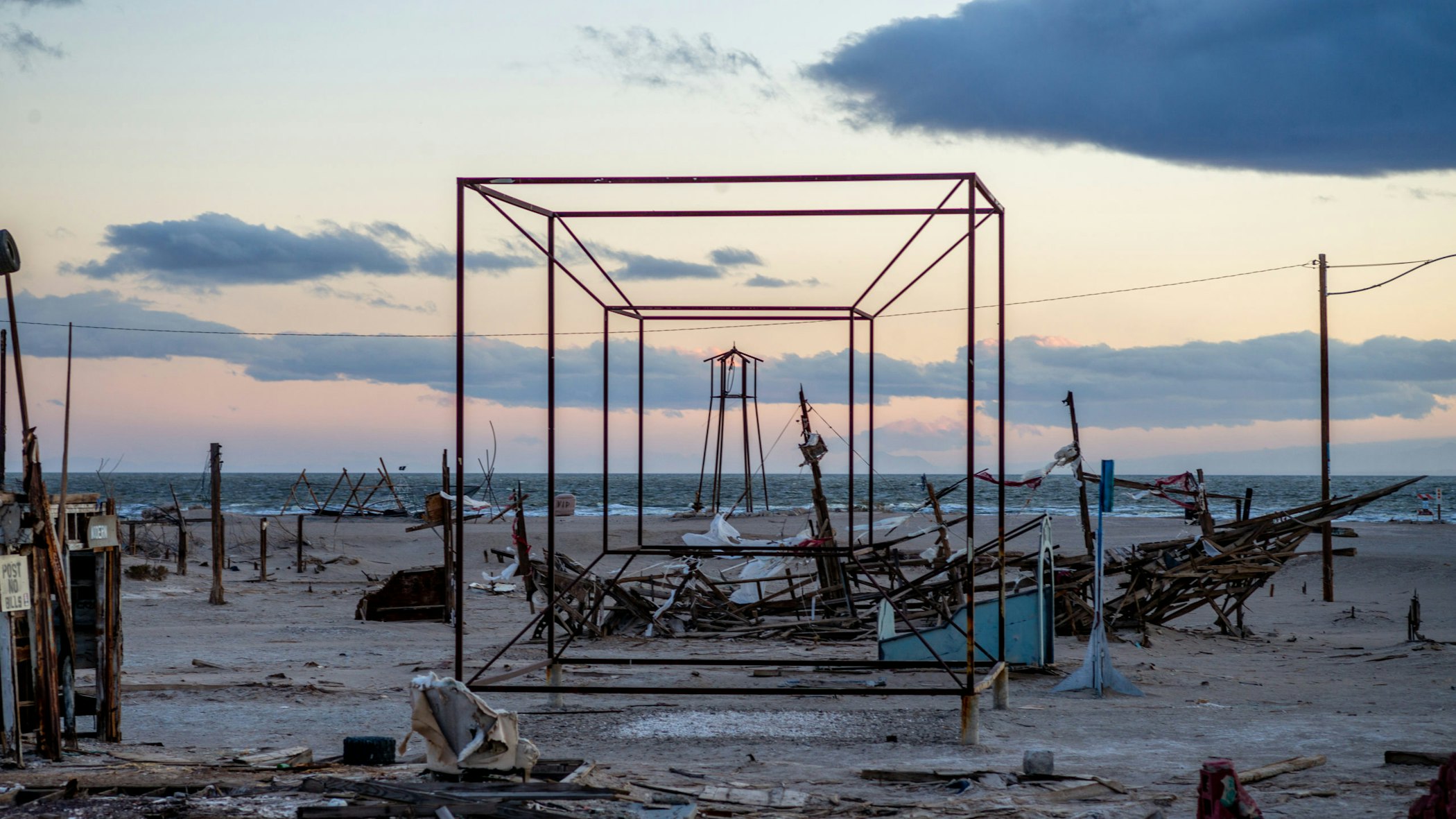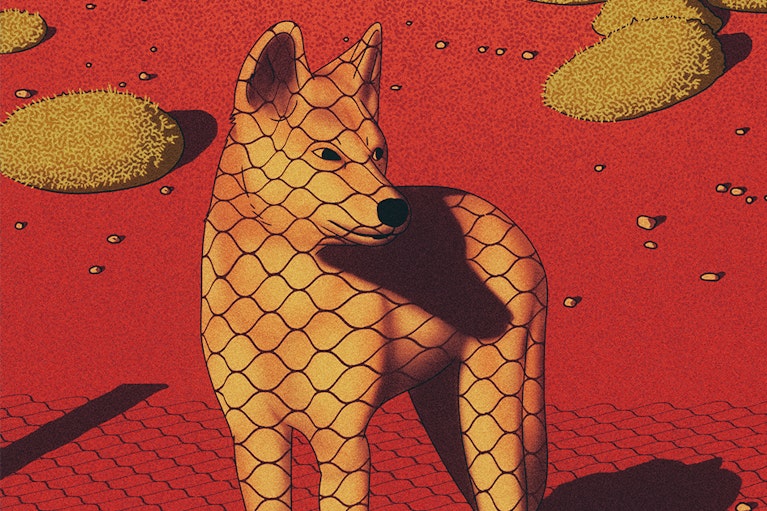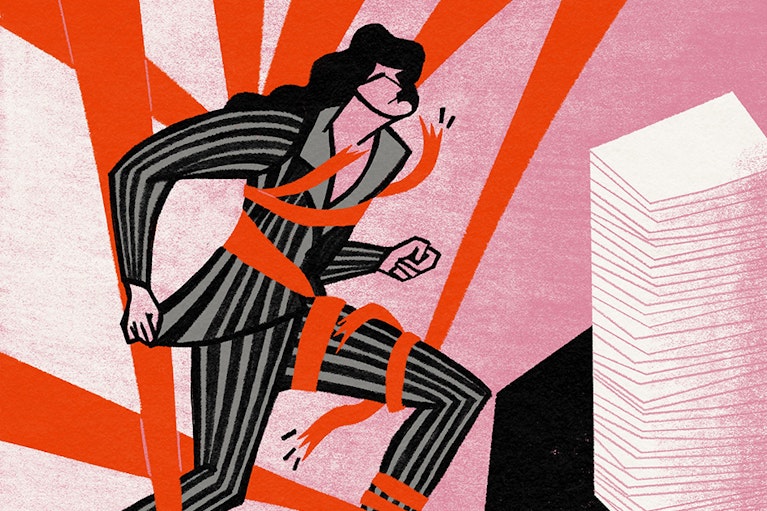Johanna Hoffman is a 2021-22 Berggruen Institute Fellow and an urbanist working in the space between design, planning, fiction and futures. Her first book, “Speculative Futures: Design Approaches for Navigating Change, Fostering Resilience and Cocreating the Cities We Need,” is slated for publication in the fall of 2022.
Photography by Tao Ruspoli for Noema Magazine.
“The inferno of the living is not something that will be. If there is one, it is that which is already here, the inferno that we inhabit every day, that we create by being together.”
—Italo Calvino, “Invisible Cities” (translated by Mark Purcell)
A town on the edge of a toxic lake might seem a strange place to look for the future. Over a hundred miles southeast of Los Angeles, alongside the Salton Sea, Bombay Beach is a stretch of mud and sand wracked by hazardous dust storms, trash-filled lots and the smell of fetid algae. Its shores are also home to a burgeoning, surrealist art hub. Walk the town’s cracked streets and you’ll see aluminum-covered planes emerging nose-first from the ground, metal cubes that glow in the night and monopoly boards stretching 50 feet wide.
Art is new to Bombay beach. A thriving resort spot during the mid-20th century, the area once drew people like Frank Sinatra to boat, fish and drink under the desert sun. By the 1980s, however, ecological demise fractured its relaxing veneer. Agricultural pollution, plummeting water levels and poisonous air spiked. Businesses and bars shut down. Homes were left vacant and vandalized. The town’s population plunged.
In recent years, that context of ruin and decline has served as a foundation for creative rebirth. Since 2015, a festival dubbed the Bombay Beach Biennale has re-envisioned the town as a moveable feast of installations, talks, parties and performances. Artists are moving in and buying property in town, transforming broken trailers and piles of aged insulation into an opera house, museum, drive-in movie theater and more. While the official number of residents has hovered around 300 for years, the price of land has risen — perhaps driven in part by the growing amount of art, but echoing trends in other regions of the country as well. The beach has grown dense with concrete stars suspended in the air, doorways leading to nowhere and rebar towers hulking into the sky.
When I arrive on a winter Thursday morning, months before the festival is slated to start, the beach is as full of people as it is art. Groups flit from sculpture to sculpture — a wooden swing standing alone in the shallows of the lake, a metal sign reading “THE ONLY OTHER THING IS NOTHING” — laughing as they pose for photos and wave hello to others passing by. Some offer drinks of water. Some shake bags of nuts or slices of fruit. Three gray-haired women hand out buttered toast from folding tables set alongside the carcass of an old boat. Its cracked hull lurches over the sands like the ribs of a desiccated whale, casting lines of tilted shade over the women and their offered food. Few on the beach seem to know each other — conversations are short and hugs of greeting scarce — but they’re still quick to share essentials.



Watching this sharing amid the detritus of the beach’s past makes me think of how disaster can foster new degrees of care. Rebecca Solnit explores the connection in “A Paradise Built in Hell,” articulating how amidst the destruction that disasters enact, more considerate and caring communities often arise. It’s a dynamic that can spark deep joy for those who experience it, Solnit writes — a joy that “reveals an ordinarily unmet yearning for community, purposefulness and meaningful work.” Such outpourings of solidarity typically dwindle, however, once the memory of devastation fades. While disaster can offer a glimpse of more compassionate futures, the challenge is to make that compassion last.
The giving happening on Bombay Beach’s beach feels like that more compassionate future come to life. It confirms the suspicions that brought me to this tiny desert town in the first place — that ruins might be key to enacting the more supportive futures this century demands. Here, on the edge of a lethal sea, the air laced with the light stench of rotting fish, strangers treat each other as something more than strangers.
***
“They used to call us a ghost town.”
I’m at the Ski Inn, one of two bars in town, talking with its owner, Sonia Herbert. She’s a spry, silver-haired woman in her seventies, a green silk scarf tied ascot style around her neck and a swipe of gloss making her lips sparkle when she speaks. Tao Ruspoli, who co-founded the Biennale along with Stefan Ashkenazy and Lily Johnson White — and who provided the photographs for this piece — introduced us.
The bar sits at the opposite side of town from the beach, past pockmarked trailers, barbed wire coils and a house topped with a life-size sculpture of a yellow and orange cow. The sign in front reads “Lowest Bar in the Western Hemisphere,” a reference to the fact that Bombay Beach is hundreds of feet below sea level. Red vinyl booths fill the room inside. The walls and ceiling are covered in $1 bills written over with the dates and names of past visitors.
When I meet Sonia, she’s wiping down the dark wood counter, a row of midday patrons nursing beers on stools nearby. She checks in with people as she works, asking a gray bearded man if his wife was feeling better, touching base about the banana tree in another man’s front yard. It didn’t look too good when she saw it last, she observes — did he need some help taking care of it?
When I ask about the history of Bombay Beach, she tells me that it’s teetered on the edge of sanctuary and disaster for decades. The sea that exists today was accidentally created between 1905 and 1907, when a ruptured irrigation ditch from the Colorado River flooded the low lying plain. As the years passed, the newly-created lake became a crucial migration and nesting site for hundreds of species of birds. By the 1950s, Bombay Beach likewise began to flourish as a resort spot attracting visitors from Los Angeles, San Diego and beyond.
Because the Salton Sea lacks natural inflows, however, water began to evaporate, slowly at first and then at speed. Salinity levels rose. Local farmers began adding their wastewater, inadvertently polluting the lake. A massive fish die-off occurred, followed by a plague of avian botulism. A 2003 transfer funneled water toward coastal areas, inadvertently causing levels to drop even more. Once the state stopped replenishing the lake’s water entirely in 2017, evaporation rates skyrocketed. As the Salton Sea dried, contaminants turned airborne, creating a fowl-smelling ecological crisis. Media outlets painted the place as poison, scaring away visitors.
“I was ashamed to tell people I lived in Bombay Beach in those days,” Sonia says. “A lot of us were.” She first arrived back in the ‘70s, when the resort heyday was still in swing. Crime wasn’t much of a problem then, she remembers. The town was a place to relax and play. On full moon nights, people got drunk and skinny-dipped in the lake. They rode dune buggies over the sands and howled at the stars. The land never stopped being beautiful when things went downhill — Sonia waxes poetic about the cactus blooms filling the air in spring with scent and the bird migrations turning the sky into cascades of undulating ribbons — but the town became a shell.
That’s when Bombay Beach began to attract a new kind of visitor. Los Angeles-based artists drove out to use its run-down trailers and blown-out cars as background for photo shoots and music videos. Tourists came for pictures of dead fish and rusted four wheelers. As the recreational wonderland transitioned into post-apocalypse, outsiders flocked to ogle the site’s unfurling decay.



Ruins have inspired similar kinds of objectification for millennia. For many, they’re visual objects, things to romanticize, fetishize and look at from afar. It’s a simplified way of seeing that lends itself to extraction more than engagement, a kind “over-aestheticization of past eras,” to borrow the words of sociologist Hanna Göbel. Henri Lefebvre explored the phenomenon in 1968, writing that his version of “urban hell” was people rushing “towards the ruins of ancient cities to consume them touristically, in the belief that they will heal their nostalgia.”
Emphasizing the visuals of ruination offers an emotional buffer from the economic, political, and social issues that lead to ruin’s rise. Focusing on the looks of a devastated space is easier than confronting the reasons why it was devastated in the first place. Bombay Beach sparked this ruin porn dynamic for years, acting as a receptacle for outsiders to extract images of its demise, before leaving when darkness fell.
Curious how art might cultivate a more reciprocal relationship with the town, the Biennale’s co-founders took a different approach. The three mined their art world connections, inviting contributions from writers, philosophers, artists, musicians, and dancers. Fashion designer Bella Freud made graphics. Grammy-winner Alex Ebert painted a backlit canvas with his own vomit while a pianist pounded chords. A principal with the San Francisco Ballet performed. The New York Times called it the “anti-Burning Man,” and a suite of biennales occurred on site in subsequent years. While COVID-19 canceled events in 2020 and 2021, programming for 2022 is taking place.
For all the attention the events have received, the Biennale is less a periodic festival than a movement to remake the town. While some activations occur specifically during the yearly gatherings, more artists have bought lots to transform into lasting spectacles and exhibition spaces, turning Bombay Beach into a kind of living museum. The Bombay Beach Yacht Club, a corner plot filled with old boats and curving chandeliers, sits close to a community cafe. The Angler Grove is a house cut with curving windows that open onto disco balls glinting off the interior walls. Shipping containers filled with large print photographs dot the edges of dusty streets.
As Stefan Ashkenazy said in a 2019 interview, the Biennale is not so much an event as a “permanent engagement,” an effort to build an artistic hub that provides facilities for locals and visitors both. The dynamic echoes social and cultural geographer Tim Edensor’s idea of ruins as fluid spaces, where limits on material curiosity and imagination are let go, and exploration of alternative futures can thrive. Artists have become an active part of the community as a result, using creativity as a reason to clean up trash, get involved in local politics, employ other residents and cultivate a new identity for a town at the edge of the world.
As Sonia puts it, “They’ve renewed us.”
Thomas Rhodes, a bartender at Ski, says the art installations are a way to link people who might not otherwise connect. He’s wearing a tie-die shirt with the words “Hippie Drip” on the front, thick black glasses framing his face, his arms dark with tattoos. He’s not working today, he says, but still came in because he loves the company.
“Experiencing something together is powerful,” he adds. “The art is a shared experience that bonds us.”
Yet not everyone loves the Biennale’s impact on the town. I talk with an elderly man named Dino later in the day, who explains that “the art’s not my preference.” I find him at his house a few blocks from the bar, an orange dune buggie listed “for sale” in his front yard, and an array of vintage washing machines piled high in an opposite corner. He welcomes me inside, where an entire living room wall is filled with his collection of Pez dispensers, an army of fuchsia, green and navy pieces lined together in plasticine rows.
The artists, he goes on, are “insular. That’s nothing against them. They’re making some good changes in town, but just in a different kind of way.” Dino’s dogs clamor for attention as he talks, and he pauses to scoop a tiny chihuahua onto his lap. “It’s not the Bombay Beach I grew up in.” Dino says he first started coming to town with his parents in the 1950s. When the resort economy began to boom, town life revolved around the sea, attracting people who liked to waterski, boat, ride dune buggies and fish. When agricultural pollution accelerated in the ‘90s, sparking the fish die-off and population decline, that outdoor recreation-based lifestyle ended too.



The artists moving in have created a new chapter. While Dino likes the fact that they energize the place, he notes that they’re “a new class of people,” with different ideas for what the culture of Bombay Beach should be. Many artists seem wealthier and more educated than other residents, creating new tensions about the town’s identity and the kind of people it attracts. Despite the changing character of the town, however, gentrification doesn’t appear to be a big concern. “It’s part of what could be,” says Ryan E. Kelley, who represents the area on the Imperial County Board of Supervisors, “but it’s not a massive issue now.”
Those who vocally support the Biennale are equally vocal about its limits. When I talk with Auggie Sadorra, the community’s Board Secretary, he’s emphatic about the need to address the area’s longstanding economic slump. “It’s good that artists are investing in the town,” he says, “but we need some kind of industry here.” When the sea was healthy, it was a financial engine. While the Biennale has cultivated some commercial activity, drawing visitors to spend money in town, nearly 10% of residents still live below the poverty line. “We need to save the sea,” Sadorra maintains. “That’s the big issue.”
It’s a point with which Biennale organizers agree. One artist addressed the matter head-on in 2018, installing a neon sculpture reading “SAVE ME” in the lake, the words reflecting red off the sundered shallows.
***
In some ways, what’s happening at Bombay Beach is nothing new. People have been inspired to create new spaces, rituals and infrastructure amongst ruins for millennia, artists in particular. From London to Berlin to Rome to Manila, many cities have been continually built anew atop the wreckage of their pasts, with creative groups often leading the way. Envisioning what can be is a way to relate to ruins not as places of demise and destruction, but as containers for new, often unexpected futures to emerge.
The approach calls to mind anthropologist Anna Tsing’s ideas about ruins as fertile ground for new life. She details the concept in “The Mushroom at the End of the World,” using the matsutake mushroom as a focal point for exploring what survival and environmental renewal might look like in a post-industrial, post-capitalist world. That devastated places like heavily logged forests or nuclear wastelands can give rise to some of the most productive mushroom spots is, to Tsing, proof of “the possibility of life in… ruins.” The matsutake shows a “willingness to emerge in blasted landscapes,” a willingness that “allows us to explore the ruin that has become our collective home.” For Tsing, ruins are places that support the unruly, entwined strains of existence, proving that life can thrive long after apocalypse occurs.
Like Tsing’s matsutake mushrooms, residents of Bombay Beach show a resilience born from living in ruins. The town is a physical reminder that success and devastation are two sides of the same coin, knowledge that provides incentive to look beyond the nostalgia that ruins so often inspire. While the allure of what was is still alive in Bombay Beach, with some still longing for the vanished fishing and boating paradise, many residents don’t seem interested in glorying what came before. The town’s ruins, impossible to ignore, act as a kind of standing challenge to the logic of its past.
Challenging the past as a viable template for the future is an important part of envisioning and enacting new futures. The parts of the brain responsible for creative imagination are directly linked to those that store and manage memories. Our ideas about the future are essentially tapestries remixed from of our memories of former days. We can’t imagine what we haven’t in some way already experienced, whether that experience comes through books, films, or direct encounters. Re-shaping ruins can be a means of diversifying those memories, building a greater imaginative repository for enacting alternative trajectories.



Many Bombay Beach residents are tacitly embracing this approach, using art to reshape their homes, streets and gathering spots. Thomas guides me through the town, describing the spaces he likes the most. A woman who cleans houses covered her trailer with large colored butterflies. Jack Parker, the local plumber, transformed his lot with dozens of stacked TVs painted in rainbows of yellow, blue, black and gold. Thomas, who lives in another community a short drive away, is remaking his fence with carefully selected railroad ties and pieces of curving driftwood.
He’s confident that if he ever needs a hand, the support is there. “People help each other here,” he says.
We walk by a group repairing an array of power lines as we chat. Almost as if on cue, one of the workers calls “I love you, man!” to the guy working beside him. “I love you too!” the other man yells back.
The creativity people are bringing to their homes is an extension of the care Bombay Beach inspired long before the Biennale began. Many small towns foster solidarity and connection. Harsh landscapes inspire support as well. For all its breathtaking sunrises and sunsets, the Salton Sea is a severe place. Temperatures regularly hit 120 degrees Fahrenheit in summer. Windstorms flood the air with noxious dust. Dead fish and birds often line the lake’s shores. The land is a constant reminder that the universe can be harsh, that survival is a battle. While there’s a strong individualistic streak in town, there’s also an appreciation for the mutual aid that living in such an intense environment requires. Living in places where life takes extra effort means that going it alone isn’t an option.
The Biennale builds on that pre-existing context of care. Its installations and programming are ways of sparking conversation, of cultivating experiences that foster community and care that grows. “It’s not the only way to form that kind of bond,” Thomas insists. “You can walk out here on a full moon and have your mind blown, it’s so beautiful. But the art helps too.”
Most of the Biennale stuff goes over his head, he says, “but I like it.”
***
As a post-apocalyptic space, Bombay Beach is a coming attraction of what lies ahead, an example of the cutting edge of everything that could go wrong. Climate change will enact more ecological destruction. Cultural differences between neighbors will likely grow. Economic instability, already raging, seems poised for acceleration. What’s happening in Bombay Beach may be a preview of what will soon be happening everywhere else.
The town’s compassionate side serves as a different kind of preview, suggesting that ruins can play a powerful role in creating the more supportive futures we need. Human geographer Leila Dawney describes ruins as potent “containers for emergent forms of inhabitation in a damaged world.” Relating to ruins as more than nostalgic, fetishized objects interrupts our memory cycles, reminding us that place can be remade in imaginative ways even when conditions are harsh. Reshaping ruins activates the future through experimentation with the past, a dynamic that both shifts embedded memories of physical spaces and diversifies what and how we imagine what can be. As places where disaster has already occurred, ruins are proof that life continues even when everything goes wrong — and that beauty and connection can be cultivated in the process.



That aspect of process is key. When ruins become ground for creation rather than objects from devastated pasts, they cultivate belief in what’s possible. It’s a shift that people like Tsing insist is essential to moving beyond extractive cycles of “promise and ruin, promise and ruin.” Seeing ruins simply as places of demise is akin to treating landscapes as sites of exploitation, to be used until resources are drained and a new site is targeted for the extractive cycle to start again. Tsing encourages us to look beyond those simplistic narratives, and to ask what else ruins might allow to emerge.
Relating to ruins as a process likewise reorients how we relate to time and space. As portals to past realities, ruins have the capacity to cultivate connection across history, geography, and culture. As cultural geographer Karen Till writes, they can foster a kind of “witnessing to respect those who have gone before.” It’s that witnessing, she explains, that facilitates appreciation of the lived experiences of different inhabitants, which in turn sets the stage for more “experimental communities to imagine different… futures.” Deeper connections between people support more creative imagination of what’s possible.
Seeing development itself as an ongoing process of ruination, as a process to be embraced rather than fought, could be a paradigm shift in how we navigate the instability of coming decades. When ruins become places for celebration and growth, they challenge the narrative of inevitable decay. They offer us the chance to cultivate Lefebrve’s ideas of “the right to the city” through the experience of everyday inhabitation.
The ongoing work of making the spaces in which we live cultivates a kind of alchemy, in which stronger links between people and place can arise. Rather than waiting for disaster to occur, it’s possible to engage with spaces as ruins already in the making, strengthening those links, and sparking new ideas of what the future can be as a result. Understanding that the ground we walk on is in a state of constant transformation is a powerful invitation to remake it, continually, anew.
It’s sunset by the time my chat with Thomas ends and I head toward the beach to take in the colors. I walk past lots piled with rusting cars, a giant metal fish faceted with mirrors and glass balls suspended two stories above the ground. I round a gutted van, its seats replaced with fake shark heads, and see a man filling a trailer bed with trash bags from the front yard of a house painted in streaks of pink, turquoise and aquamarine. He waves a silent greeting in my direction before turning toward a neighbor approaching from the other side of the street.
“Do you want this paint?” the man with the trailer asks his neighbor, holding up a pair of rusted cans. “I’ve got some old screwdrivers, too.” The two lean over his trailer bed to discuss further, their shoulders lightly touching and heads bent close.
I pass the dirt levee that edges the western side of town, built in the ‘70s after floods wracked the region, and step onto the beach. The sky is a rage of crimson, umber and chartreuse. Birds are shouting and diving along the water’s edge. A flock hovers around a wooden sign reading “HELP OUR SEA.” A couple of girls dance nearby to music playing from their phones, laughing as they move. Farther down the shore, a group of three stands by a blue and yellow newspaper dispenser, pouring cups of wine to share from a bottle. I walk toward them, my nose full of the light stench of aging algae, my arm raising to wave hello.







